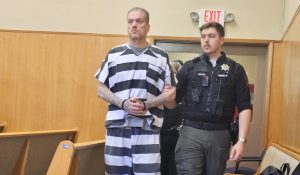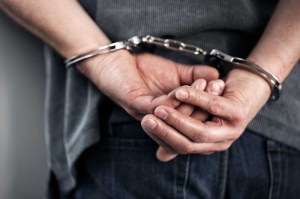Blazing trails across the West
Published 4:00 pm Tuesday, November 4, 2003

- Former Prairie City resident Ben Kern, a wagonmaster in his own right, recently stopped at Ox Bow Trade Co. in Canyon City and checked out this little buckboard. The Eagle/HEATHER SHEEDY
JOHN DAY – Have you ever wondered what it was like to be a pioneer? Setting off to make a new life, a better life, in the West. Heading out by wagon train to parts unknown, sleeping under the stars, cooking over an open campfire, spending leisure evenings telling stories or listening to harmonica and fiddle music.
Trending
All that was part the early-day wagon trains along with other not-so-glamourous experiences such as traveling dusty roads for months in sometimes inclement weather, fording treacherous rivers, passing through Indian territories, and dealing with breakdowns and sickness along the way. Many made it to the “promised land”; others didn’t. It’s an experience we could never re-live exactly. But there is a way to sample the pioneer spirit – join a modern-day wagon train.
“Come on along and be part of re-creating the trail,” urges former Prairie City resident Ben Kern. In recent years he has blazed new trails on historic routes actually used by pioneer travelers. Kern became involved in wagon trains in 1969 when a group from Grant County headed to the Pendleton Round-Up with horse- and mule-drawn wagons. His love of the Western lifestyle began long before that.
Kern was raised in Wyoming and settled at Prairie City in 1947. In 1948, he married Shannon Mangun and they had two children, daughter Kelly and son Kit. His early days in Grant County were seasoned with ranch work at the Oxbow Ranch, then he was employed at the Byron Lemons Ranch below Mt. Vernon. In 1951, he married Billie Glasgow, who had two children, Jaylene and Kyle. Misfortune claimed Billie’s life in a car accident west of Prairie City in the late-1950s.
Trending
Ben and his father, Loyd Kern, leased the Kent Ranch above the Oxbow Ranch and ran it for about six years, then he worked a couple of years at the Tuttle Hereford Ranch, which encompassed the Blue Mountain Hot Springs area and the Reynolds Ranch. After a move to Unity, he was a ranch hand at the Harold Grabner Ranch for a year.
Like many others, he worked in the timber industry for Ellingson Logging Co. at Izee, G.L Pine Co.between John Day and Prairie City, and Blue Mountain Mills at John Day.
As a Prairie City business entrepreneur in the 1960s, he owned the Coffee Cup Cafe, which was renamed the Branding Iron Cafe and Lounge. He kept his hand in ranching as he tended cattle for the Franke Brothers, who leased ranches in Grant and Harney counties.
During this time, a group of Prairie City folks formed a wagon train club and planned their first excursion to the Pendleton Round-Up in September 1969. Ben and Vi Robertson Coley married the morning the wagon set out from Prairie City. (Vi’s children include: Leonard Coley, Maureta Coombs, Steve Coley, Carol Coley and Stan Coley.)
Bob and Rosita Stanbro of Prairie City were part of the group on that first local wagon train adventure and recalled that the Pendleton Round-Up had provided most of the stock and wagons for the Prairie City group.
“A lot of work went into the planning,” said Bob Stanbro, “but it was a good vacation after we’d been on it for a few days.” The Stanbros used one of Pendleton’s wagons, but borrowed a white mule, Hannibal, from Pete Baucum and a dark mule, Rosie, from Bill Winegar.
All told, seven wagons and about 20 Grant County folks, including Ben and the Stanbros, embarked on the excursion to the Pendleton Roundup. Bill Winegar was wagonmaster joined by his wife, Mary, George Winegar, Ray and Etta Nelson, Al and Erma Lee Oard and Gifford and Ila McIntosh (Ben’s mother), Wilbur King and others. The wagon train made quite an impression during the Pendleton Round-Up Parade. While there, Ben and his new bride were dinner guests of Yakima Canutt, a saddle bronc rider who rode his way to fame at the 1919-20 Pendleton Round-Up Rodeo and later became a stunt man for John Wayne and other famous actors.
After the Pendleton Round-Up, most of the club members were hooked on the experience, and many got their own rigs, said Rosita Stanbro.
The Wagon Train Club also made showings at the Vale Round-Up and Rodeo, Paulina and Burns, and added other local folks such as Chuck and Tina Hill, Louis Kimball, Herb Bezona, George and Virginia Winegar and their son 23-year-old Jerry, who was the youngest participate. As they attended organized events or headed into the Blue Mountains for impromptu outings, they dressed in period clothing and lived the pioneer life with Dutch-oven cooking and old-time music by fiddler Gifford McIntosh and other musicians. They once rode along with a wagon train that was passing through Baker County. For the Prairie City club members the involvement in wagon trains passed and they retired from action in the late 1970s. But Ben Kern hung onto the idea and drove it down the road a little further.
He moved back to Wyoming in 1978 and worked for Allamand Oil Field Construction. He was an equipment operator for the City of Casper Parks Department from 1983-92, and helped plan for the Oregon Trail Centennial by researching the Oregon Trail route, then secured permits and selected camp sites – everything that was needed to travel. On May 2, 1993, the wagon train left Independence, Mo., and reached the destination at Independence, Ore., on Oct. 21, 1993. Ben drove the lead wagon; Morris Carter served as wagonmaster. With seven wagons and 25 people, they traveled the complete Oregon Trail – nearly 3,000 miles. Many others joined the event for shorter distances along the route, which included driving through the center of Kansas City. The group also took a side trip to the Oregon Coast at Hat Rock near Lincoln City.
Since then, Ben Kern, wagonmaster, has been on a roll. It’s become a part of his regular life at home in Evansville, Wyo. If he’s not on a wagon train excursion, he’s planning for one.
He’s retraced the ruts of historic wagon trails and has created an opportunity for many others to participate in the humbling experience.
“On the long trails, a group of people really get bonded living together every day,” said Ben. At the end of the journey some were just unable to say “good-bye” or became very emotional and went off to a corner to cry, he said.
On the average, a wagon train can travel 15-20 miles per day. Support vehicles along the way provide water and port-a-potties. When the train reaches its daily destination, the chuck wagon, showers and other amenities await.
Many men and women leave city life to join the adventure, determined to finish. Along the way they gain a better understanding of the early-day hardships our forefathers endured as they settled the West. A few children are brought along, but Ben says if he had his way he’d “fill a wagon with kids so they’d have something to tell about someday.” Most participants live the experience to the fullest and some return for another dose. The cost to travel with the train depends on the expenses involved for each trail. Fees are figured for walkers, horseback riders or those with teams and wagons. Participants bring their own camping gear and tents.
A roster of wagon trains which Kern has orchestrated to date include the following:
1994 -Goodale Cutoff from Fort Hall, Idaho, to Boise. 250 miles; 16 wagons. Ben teamed up with Les Broadie. Called the Northern Route when the Oregon Trail was shut off by the Blackfoot Indians.
1995 – Blane County Centennial loop route. Arco, Idaho, to Sun Valley, Idaho, then north to the Copper Basin following ore wagon trails and back to Arco. Kern and Broadie; 12 wagons.
1996 – First leg of the Mormon Wagon Train from Nauvoo, Ill., to Omaha, Neb. Barge transported the whole train across the Mississippi River to Montrose, Iowa. Traveled 550 miles. Left Nauvoo on June 1 and arrived in Omaha July 6. The Mormons originally used Omaha as their Winter Quarters, then left the following Spring for Utah.
1997 – Second Leg of the Mormon Wagon Train from Omaha, Neb., to Salt Lake City. Three wagon bosses, Joe Vogel from Red Cloud, Neb.; Ben Kern across Wyoming; and Bob Lowe across Utah. When the wagon train arrived at Salt Lake City around 45,000 people were there to celebrate with them. This re-enactment depicted the Centennial of the Mormon exodus into Utah.
1998 – Planned for the California Trail.
1999 – California Trail, an all-mule train. Left St. Joe, Mo., on April 26 and arrived in Coloma, Calif., on Sept. 5. The journey was 2,600 miles. Stopped at Casper and performed ground breaking in preparation for a $15 million National Historic Trail Center. Boston Productions filmed part of the wagon train route and staged a mishap at a river crossing in the Platte River near Bessmeer Bend, south of Casper. Began with 15 wagons and added five more along the way in Idaho and Nevada.
2000 – Planned for the Bozeman Trail.
2001 – Traveled the Bozeman Trail from Fort Laramie, Wyo., to Virginia City, Mont. 765 miles; 28 wagons. Crossed the Crow Indian Reservation. Forded the Big Horn River at the actual crossing, Spotted Rabbit Crossing. Film crew came from Billings, Mont. Traveled up the Yellowstone, through Ennis, camped on the reservation at Chief Plenty Coup Park, a very sacred spring area. Michael Martin Murphey traveled with them for a few days and entertained.
2002 – Started the Cherokee Trail. Traveled backwards from the actual route. Started at Fort Bridger, out of Evanston, Wyo., to Flaming Gorge, south of Green River, Wyo. Red Steagall poet and singer, who is featured on “Cowboy Corner” and has been inducted into the Cowboy Hall of Fame, met up with the group for a visit.
2003 – Second leg of the the Cherokee Trail, from Flaming Gorge to Encampment, Wyo.
2004 – Will complete the Cherokee Trail from Encampment, Wyo., to Fort Collins, Colo.
With all this under his belt, you’d think Ben Kern would be satisfied to relax on the “back 40.” That’s not exactly what he’s been doing, he worked full-time as a cowboy last summer tending 10,000 head of cattle for the Q Creek Land and Livestock Co., headquartered near Medicine Bow, Wyo. And on the agenda for 2005-06 is the Cherokee Trail from Fort Collins to Old Bents Fort on the Arkansas River in the Southeast corner of Colorado. Another goal is to travel the Custer Trail from Fort Lincoln, N.D., to the Little Big Horn River in Wyoming where Custer had his last stand.
One of his greatest accomplishments, he said, was gaining cooperation of Crow Indians to across the reservation for the Bozeman Trail in 2001. Many had told him it couldn’t be done, but in the end he proved them wrong.
His wagon trains have attracted many people to the State of Wyoming, so much so, that Wyoming Tourism sponsored the wagon trains through 2002.
It’s hard to imagine the the smorgasbord of memories from such journeys into the past – from run-away wagons to the many friendships that have evolved. Memorable acquaintances such as Chuck Quillan and his mule team from New Sharon, Iowa; Joe Adams and Lloyd Ware of Burley, Idaho; and 91-year-old Chuck Miller of Abzerke, Mont., who drove every day of the Bozeman Trail ride. Also the English lady, Sue Smith, who operates a three-star Bed & Breakfast on Vancouver Island, British Columbia. Smith, a repeat adventurer, walked every step of the Oregon Trail, she also walked other Goodale Cutoff, Blane County Centennial and the Mormon Trail.
If Ben Kern’s face looks familiar, that’s no surprise because he passes through Grant County on occasion; his most recent trip was in mid-October for his mother’s, Ila McIntosh’s funeral. His brother, Bob, lives at Pendleton. A few years ago, Ben had a book signing in John Day for “Wagon Wheels.” The co-author, Candy Moulton of Encampment, Wyo., has been on all the wagon train rides and the book is a compilation of diary notes written by the two of them. Moulton also added excerpts from old-timers’ diaries. She is a member of the Oregon/California Trails Association and has published many books, including roadside histories of Wyoming and Nebraska, and is presently working on a book about Chief Joseph.
With so much traveling, Ben has friends in many places. In fact, he meets up occasionally with Jim Jenson of Canyon City, owner of the Ox Bow Trade Co. Perhaps the two will cross paths again at Rock Springs, Wyo., for the Thanksgiving weekend flea market and trade show.
Local cowboy John Aasness has roped Ben into serving on the board of directors for the developing Grant County Rodeo and Cowboy Heritage Museum. So, just maybe, Ben Kern will ride into town once in a while. Some people might not be surprised if he drove a wagon train and was joined by the remnants of the Ben Kern Wagon Train Club, Grant County chapter.
To learn more about Ben Kern’s adventures, log on to the Historic Trail Center Web site http://oregontrail.blm.gov/.









